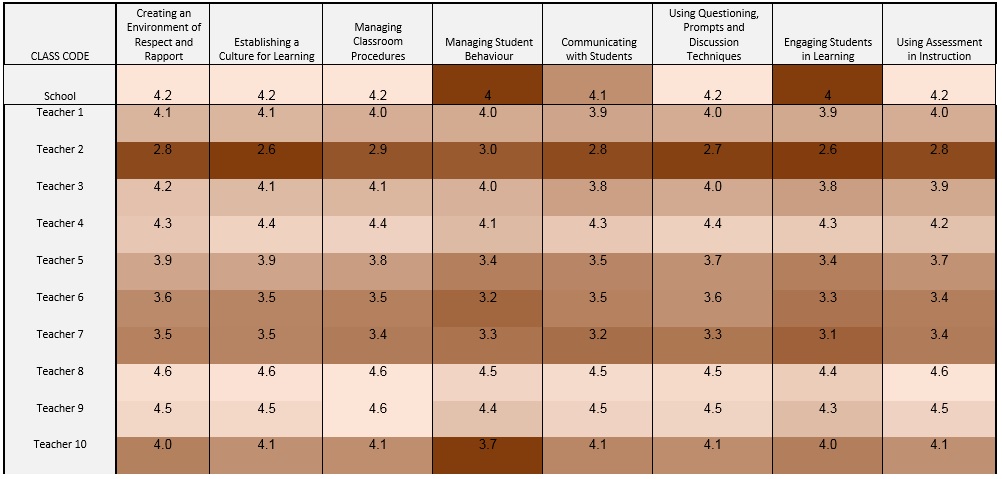Feedback is an essential part of learning, especially when we want to improve our practice and attain high professional standards. And the best form of feedback is right there in front of us in our classrooms.
Students have valuable insights into classroom teaching and how it might be improved. After all, no one observes us more than they do.
They know, for example, whether their teacher's explanations are clear, whether it feels comfortable to ask for assistance, how classroom activities might engage them more and increase their interest, how teachers might involve them more in fruitful discussions and how classroom activities might be managed more effectively.
The Student Perception of Teaching Questionnaire (SPTQ), developed by researchers at the Australian Council for Educational Research (ACER), is designed to provide teachers and schools with useful feedback about the quality of their teaching.
The SPTQ is firmly grounded in research on the characteristics of effective teaching and closely matches the Australian Professional Standards for Teachers.
Why use student perception surveys?
Research consistently shows that students are reliable sources of information about the quality of our teaching, and the most useful source of ideas about how to improve it (MET Project, 2012; Wilkerson, Manatt, Rogers & Maughanm, 2000). Student surveys are also more accurate than classroom observations at predicting achievement gains (Balch, 2012, Kane & Cantrell, 2010).
School leaders can use the SPTQ to gain a useful overview of the quality of teaching in their school, identify professional learning needs, and provide a basis for rewarding and recognising teachers who attain high teaching standards. The questionnaire can be administered annually, so school leaders are using the data to measure improvement in the quality of teaching over time.
'While test scores can reveal when kids are not learning, they can't reveal why.' (Ripley, 2012)
How does it work?
Through an online, confidential, survey students are asked about their classroom experience; factual matters about which they are in a good position to make informed judgments. They are not asked to compare teachers. The 15-minute survey can be administered referring to a single teacher or to a group of teachers.
The SPTQ has two domains and eight sub-scales, each with several items:
Domain 1. Learning environment
- Respect and rapport
- The learning culture
- Managing classroom activities
- Managing student behaviour
Domain 2. Teaching practices
- Purposeful teaching
- Effective teaching strategies
- Student engagement
- Assessment and feedback

How do schools use the results?
Schools have been using the results of the survey for a variety of purposes. One was to identify aspects of teaching that needed strengthening across the school, such as student engagement in learning, and plan appropriate professional learning opportunities to meet that need. Another purpose was to compare students' perceptions of teaching at different year levels, for different subjects or over time to measure change associated with new programs and interventions. The same reports can be used to identify individual teachers who might be in need of support or professional learning. Individual teachers applying for promotion, or for Highly Accomplished or Lead Teacher Certification, can also use the results as evidence about the quality of their teaching.
As teachers, we are all a little apprehensive about feedback from our students. However, our experience with the SPTQ is that the risk is worth it. Students act responsibly to the opportunity. Without taking risks, we limit our chances to develop professionally.
References
Balch, R. T. (2012). The validation of a student survey on teacher practice. Vanderbilt University.
Kane, T., & Cantrell, S. (2010). Learning about teaching: Initial findings from the measures of effective teaching project. MET Project Research Paper, Bill & Melinda Gates Foundation, 9.
MET Project. (2012). Asking students about teaching: Student perception surveys and their implementation. Bill and Melinda Gates Foundation. Retrieved from: http://www.metproject.org/downloads/Asking_Students_Practitioner_Brief_PDF
Ripley, A. (2012, October) Why Kids Should Grade Teachers. The Atlantic. Retrieved from https://www.theatlantic.com/magazine/archive/2012/10/why-kids-should-grade-teachers/309088/
Wilkerson, D. J., Manatt, R. P., Rogers, M. A., & Maughan, R. (2000). Validation of student, principal, and self-ratings in 360 feedback [registered] for teacher evaluation. Journal of personnel evaluation in education, 14(2), 179-192.
If you or your school are interested in working with Dr Lawrence Ingvarson and Dr Kate Reid to collect evidence of student perceptions of teacher quality, please contact them at lawrence.ingvarson@acer.org or visit the SPTQ webpage.



